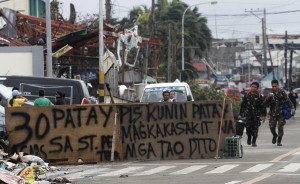Student flees Tacloban with broken dream but hopes to return

FILE PHOTO
TACLOBAN CITY—Thirty-year-old student Delma Rosel is just one of many survivors of monster typhoon “Yolanda” (international name: “Haiyan”) who desperately want to get out of this city.
After four days of camping out at the airport to get a free trip to Manila through the Philippine and foreign C-130s, she and her three nephews decided to try their luck with a Philippine Navy ship heading to Cebu.
“We heard there would be a ship going to Cebu. We’ll try our luck from there. We just need to get out,” she said.
The Navy logistics ship, BRP Dagupan, sailed to Cebu City from Tacloban on Thursday with 2,500 passengers. It is expected to arrive early Friday.
At the airport, thousands line up every day to be accommodated to the available C-130s hoping to get flown out. But only a few can get in because slots were not so many and the elderly, children and sick were prioritized.
Article continues after this advertisement“We want to start over. Maybe in a year we’ll come back,” Rosel said.
Article continues after this advertisementThe typhoon put her dreams on hold and she had to take a detour. She was one semester away from graduating from a hotel vocational course before Yolanda pummeled the Visayan region.
“I was already planning to go to work abroad if I finish my one-year course,” she said.
Instead, she will stay with her relatives in Marikina City where she plans to rest for a few weeks after her “traumatic experience,” then work to save money to process her plans to work overseas in a hotel industry.
One of her nephews, John Ray, was not as lucky. He was supposed to graduate from high school next year. But it looks like classes won’t resume anytime soon.
“I was hoping to get a seaman or accounting course after high school, but I am joining my aunt instead. Maybe I’ll get a job then go back to school when everything is okay here. Or maybe I will study in Manila,” he said.
The Rosels are from San Jose. Thankfully, they all survived the fury of Yolanda but their house was completely destroyed. Delma Rosel said that during the onslaught of the typhoon, the storm surges were “tsunami-like” and “beyond imagination.”
Delma left her parents behind. Her brother, whose house was only partially destroyed, also opted to not leave Tacloban.
“They don’t want to go with us. And they will be okay here. But we have to get out and move on,” Delma said.
She said the city will take time to recover.
‘Great equalizer’
From the airport, the road to Tacloban City Hall is a picture of devastation. Trees fell, houses were damaged, debris is everywhere, dozens of body bags were in the streets. The place beyond the airport literally stank of death.
A local government employee referred to this tragedy as “the great equalizer” because both the rich and the poor were left homeless or without food and water.
Tacloban has a population of about 230,000. But being the center of the region, it was estimated that its daytime population rises up to 500,000.
“Most of the victims were the poorest of the poor. All their life they lived hard lives. This is the only time they became equal with the rich. During the first three days even the wealthy did not have water. They also asked for help from the government to reach to their loved ones,” the employee, who refused to identify himself, said.
He also agreed with the criticism that the national government was “pathetically slow” in addressing the needs of the victims after the typhoon.
“I’ve been here from the beginning. There are still bodies in the streets. They should have started clearing the place first after the first three days before they did relief,” he said.
City administrator Atty. John Tecson Lim said that they are seeking help from the National Housing Authority to drawing up a permanent housing plan for those rendered homeless.
“The problem is, even if we get to feed them, where will they stay?” he explained.
“We also need contractors and operators to fix structures. We need to re-establish the government,” he added.